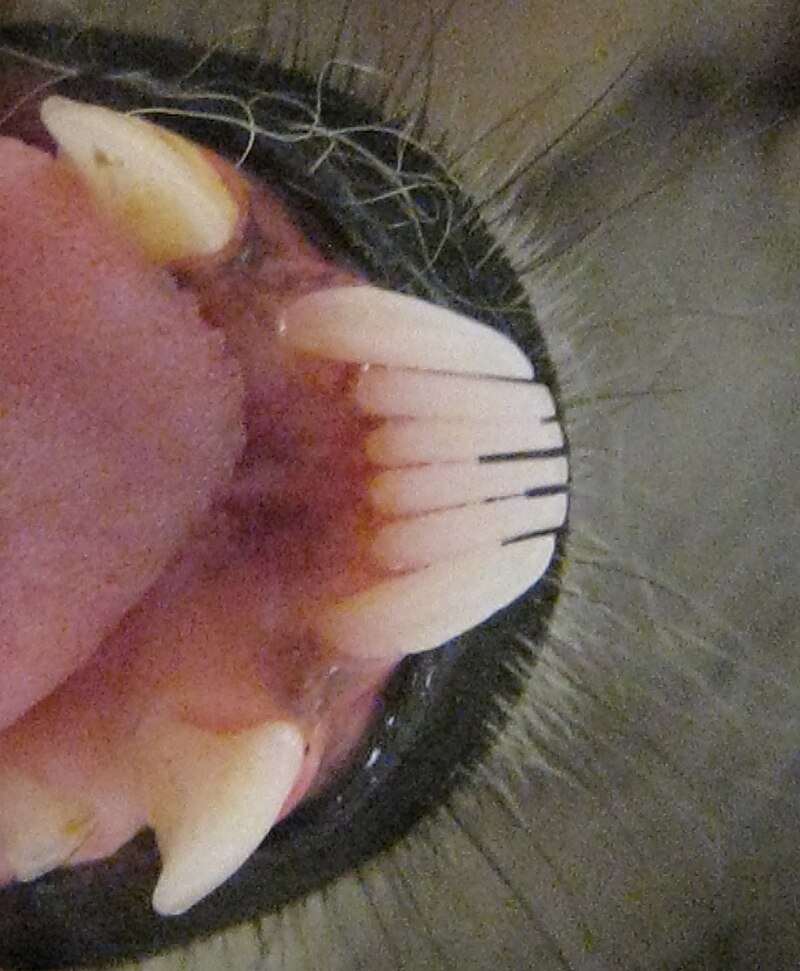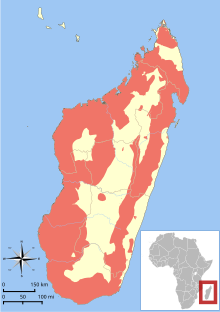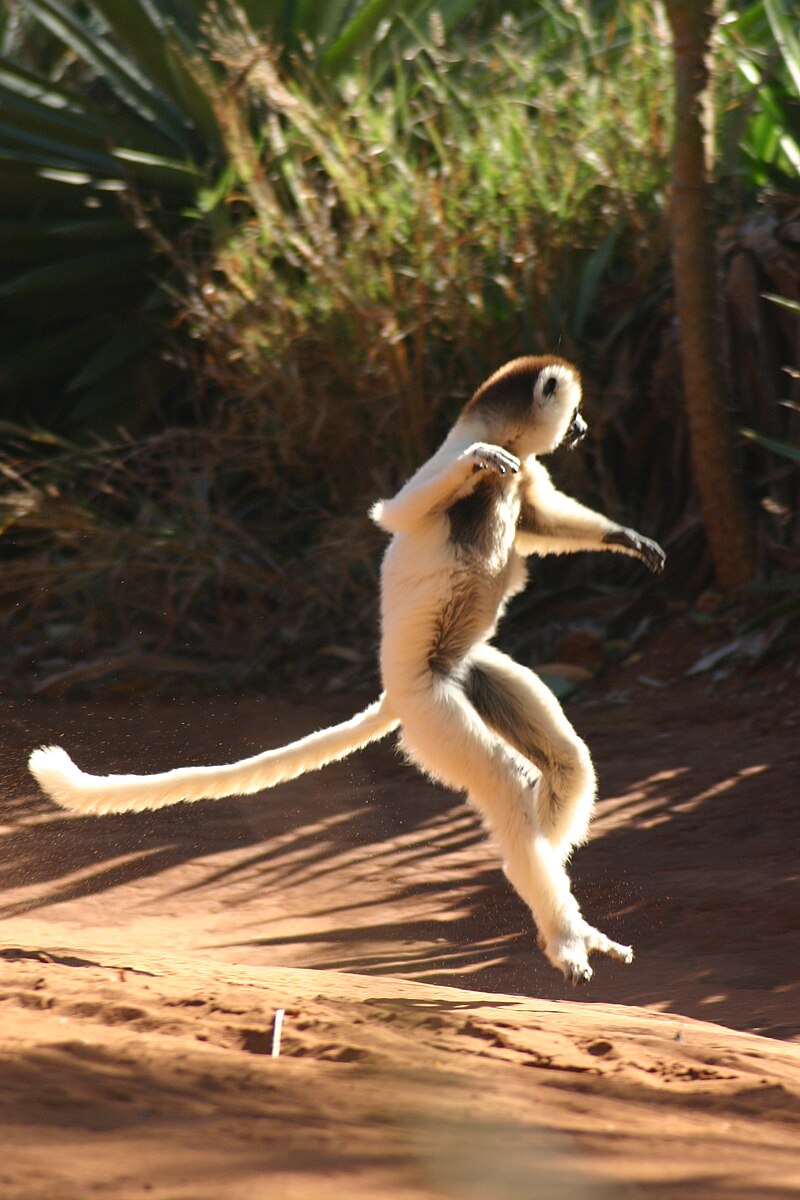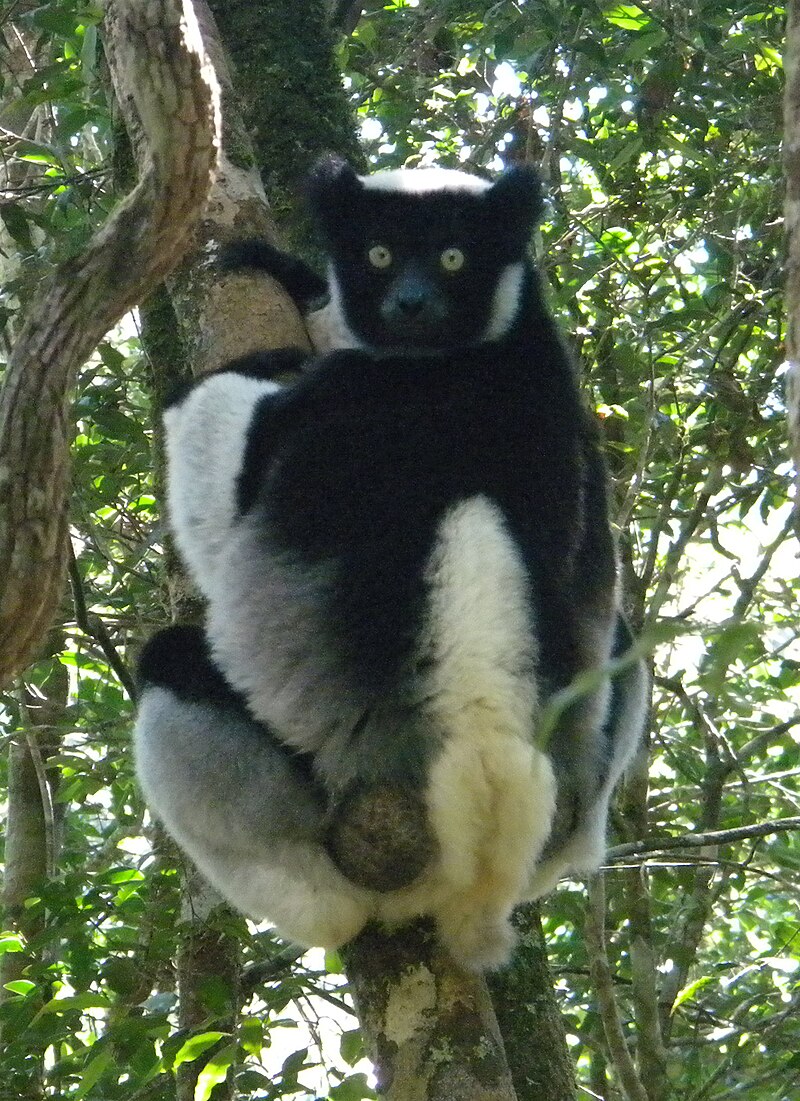Lemurs ( LEE-mər) (from Latin lemures – from ghosts or demons) are primitive mammals, divided into 4 families and consisting of 3 genera and about 5 existing species (source). A lemur is only native to the island of Madagascar. Most existing lemurs are short, have a pointed snot, big eyes, and a long tail. They are mainly in plants (arboreal) and they are active at night (nocturnal).

Lemurs share similarities with other primates but evolved individually from monkeys and monkeys. Due to the high seasonal climate of Madagascar, the evolution of lemons has created a diversity of species, competing with different primate groups.
Until shortly before humans arrived on the island some 3,500 years ago, there were large legumes like male gorillas. Since the 1990s most species have been discovered or propagated to the status of complete species; However, the taxonomic taxonomy of Lemur is controversial and depends on which species is used.
The 30-gram (1.1 oz) mouse lemur weighs in at 9 kilograms (20 lbs). Lemurs share many common basal primate features, such as nails (in most species) rather than split digits and nails in hands and feet. However, their brain-to-body ratio is smaller than that of anthropoid primates. Like all streptocrine primates, they have a “wet nose” (rhinarium).
Lemurs usually interact more with aroma and voice than most social and visual signals within the streptocrine primate. Lemur has a relatively low basal metabolic rate and may result in dormancy such as hibernation or torpor.
They also have seasonal reproduction and female social dominance. Most eat different types of fruits and leaves, while others are experts. Due to different diets, two species of lemons may be in the same forest.

Distribution and Diversity
Since beginning their journey to Madagascar, Lemurs have adapted to meet many open ecological niches. The reflection of both behavior and behavior (outward appearance) is different from that of monkeys and fools found elsewhere in the world.
The lemurs have evolved from a variety of locomotives, with varying levels of social complexity, and local water levels, to the recently extinct 160-200 kg (350 kg440 lb) of Archaeoendris Fontonti, the mouse of the world’s smallest prime madame berth in the size of 5 grams (1.5 oz). Unique adaptation.
Lemurs lack any shared features that make them different from all other primates. To counter Madagascar’s harsh, seasonal climate, a variety of lemurs have created a unique combination of unusual features.
These significant features cover seasonal fat storage, hypometabolism (with torpor and hibernation), small group size, low encephalization (relative brain size), catheterity (both day and night activity), and severe breeding season.
Extreme resource constraints and al tu breeding are also thought to have yielded three other relatively common lemurs: male-to-male competition for low-level mates, such as female social domination, sexual psyche, and sperm competition.

Before the arrival of humans approximately 1500 to 2000 years ago, lemurs were found throughout the island. However, early settlers quickly transformed forests into paddy paddies and grasslands (known locally as rivers) through slash-and-burn agriculture, limiting lemurs to about 60,000 kilometers (23,000 square miles) of the island.
Today, the diversity and complexity of the Lemur community have increased with flower variations and rainfall and are highest in the rainforest on the east coast, where rainfall and floral diversity are also at their highest.
Despite their adaptation to extremely adverse weather, habitat destruction, and hunting have led to the rapid decline of the Lemo population and their diversity, causing the extinction of at least 17 species in eight genera, collectively known as the subfossil Lemur.
About 100 species and most of Lemur’s subspecies have been threatened or endangered. If trends do not change, extinction is likely to continue. Until recently, giant lemurs existed in Madagascar.
Anatomy and physiology
Lemurs vary widely in size. These include the world’s smallest primates and have recently included several of the largest. They currently range in size from 95 kg (1520 lbs) to five –m (152) lbs) for the mouse lemur (microbus berth) and diadem cephaca (Propythex dyedema). An extinct species reflects the gorilla in the size of 160-200 kg (350-440 lbs) for Archaeochondris phontononti.

Like all primates, lemurs have five split numbers, including nails (in most cases) on the hands and feet. Most lemurs possess a chronic compressed, prolonged nail on the second toe and use it for scratching and grooming. In addition to the toilet nails, lemonade shares various properties with other strepsirrhine primates, including a rhinarium (or “wet nose”);
A fully functional vomeronasal organ, which detects pheromones; Lack of a postorbital bar and postorbital closure (thin bone wall behind the eye); The orbital (eye socket bone socket) that is not fully facing the front; Left and right mandible (lower jaw) bones that are not fully attached; And the proportion of body mass to a small brain.
Lemurs are uncommon in primates, especially for the fastest development of teeth in the largest species. For example, indriids grow in the body relatively slowly but very quickly from teeth and burst.
In contrast, anthropoid primates exhibit slow dental development with increasing size and slow morphological development. Lemons are also dental teeth at birth and have permanent teeth whilst lactating.

Senses
The sense of smell, or smell, is very important for lemurs and is often used in communication. Lemurs have long frustrations (compared to short snouts of haploorhines) which traditionally think of as positioning the nose to drive the odor better, though long snouts do not necessarily translate into high frictional significance because it is not the relative size of the nasal cavity that is related to the odor, the scent. The density of Recipients. Instead, longer snouts may facilitate better chewing.
Communication
For contact with the scent, which is useful at night, lemonade will make glands frequent in the urine, as well as inside the wrists, inside the elbows, the genitals, or the neck. Most men have scented glands on the scrotal skin of the lemurs. Ruffed lemurs (Generace variacea) and male cephaladas have a gland at the base of the neck, whereas the larger bamboo lemurs (Ptolemur seamus) and the ring-tailed lemurs are glands inside the upper arm near the axilla.
Male ring-tailed lemurs have a sparse adjacent to the thorns, they have aromatic glands on the inside of the thorns, and they simultaneously use scented mark tree stalks. They will also wrap their tail between their nozzles and then engage in a “foul fight” by rolling the tail to their opponents.
Sight
Lemurs also have a third eyelid, also known as fictitious membranes, while most primates contain less developed plaque semilunaris. The fictitious membranes keep the cornea moist and clean by fluttering across the eyes.
Metabolism
Lemurs have a low basal metabolic rate (BMR), which helps them conserve energy during the dry season when water and food are scarce. They can optimize their energy use by lowering their metabolism rate by 20% above the predicted values for mammals of similar body masses.

Behavior
Lemur behavior is just as variable as lemur morphology. It helps define differences in diet, social order, activity patterns, locomotion, communication, predator avoidance strategies, reproductive system, and intelligence level lemur taxa and determine individual species without rest.
Although the trends often distinguish small, nocturnal lemons from larger, durational lemurs, there are often exceptions that help exemplify the unique and diverse nature of this Malagasy primate.

Diet
What do lemurs eat? A small mouse eats a piece of lemon in the fruit. Mouse lemurs eat mainly fruits, though they have insects in their diet.
Lemur diets are highly variable and exhibit a high level of plasticity, although common trends indicate that the smallest species primarily consume fruits and insects (omnivores), larger species consume more of the plant material and most of the plant material. Like all primates, hungry lemons are edible that can eat anything, whether the item is one of their favorite dishes.
For example, ring-tailed lemurs eat insects and small vertebrates when needed, and as a result, it is generally seen as opportunistic omniscient. Most of the cocktail ginger mouse lemur (Mirza Koccarelli) is a consequence, but in the dry season, the pork will be dried.

The golden bamboo lemur (Hapellamur aureus) eats a large variety of bamboo (Catheriostachis madagascarinesis), which contains high levels of cyanide. Many legumes of large lemon varieties eat fruit (especially fruit), especially when eating lemonade leaves, many legumes do this at the time of fruit deficiency, sometimes resulting in weight loss.
Most lemon varieties, most of which contain the smallest lemon, and some are found mainly in fruit (freviore), except for the citrus. The bark and plant exudates, such as tree sap, consume a few lemon species. Eight species of lemurs are known as seed predators (granivores).
Soil erosion (geophagy) has also been reported and probably helps digestion, provides minerals and salts, and aids in the absorption of toxins.
Socialization
Lemurs are social and live in groups that typically include less than 15 people. The patterns of social organization observed include “lonely but social”, “fission-fusion”, “pair bond” and “many male groups”. Nocturnal lemurs are mostly lonely, but social, boiling alone at night, but often are grouped during the day.
For example, in many nocturnal species, females will nest with their offspring with other females and possibly a male, whose larger home range overlaps one or more female nesting groups.
In sportive lemurs and prickly lemurs, one or two women could possibly share a home range with a man. In addition to sharing a home, they will interact vocally or physically with their range mates while grazing at night.
Some legumes exhibit female filopatry, where females are in their perinatal range, males migrate after reaching maturity, and in other species, both sexes migrate.

Activity patterns
To conserve energy and water in highly seasonal environments, mouse lemurs and dwarf lemurs exhibit seasonal behavior cycles of dormancy where metabolism rates and body temperature are reduced. Dwarf lemurs are the only primate known to hibernate for extended periods of time.
Movement
Sifakas have been specially adapted to draw vertically and to jump, so they must be heaped to the side to advance to the ground.
Locomotor behavior in lemurs, both living and extinct, is highly varied and its diversity is greater than that of the anthropoid. Locomotive gestures and behaviors include vertical grasping and jumping (with saline behavior).
Inderidas’ jumping skills are well-documented and are popular among Ecotourists visiting Madagascar. Using their long, strong rear legs, they descend into the air of the hand and tightly hold the trunk on both hands and feet in a steep posture on a nearby tree. From the tip of the rainbow, the tree can jump up to 10 meters (33 feet) to the tree trunk, this ability is known as “ricochetal leaping”.

Communication
Lemur communication can be transmitted through sound, vision, and smell (leftover). For example, higher stereotyped behaviors such as ring-tailed lemur aromatic marking and vocalization make complex use. Visual signals are probably the least commonly used by lemurs, as they lack the many muscles used in general facial expressions.
Given their poor vision, full-body posture is probably more noticeable. However, ring-tailed lemurs have shown distinctive facial expressions, including looking threatening, being pulled behind the lips for submission, and the back of the ear with a nose during scent-marking. This species has also been noticed using it as a threat.
Their tight ledges make contact with distances, alert neighboring soldiers, and help identify troop members. Cephakus is known to display an obedient tooth-boring grimace used in open-mouth play as well as in agonistic interaction.

Primates are generally more pronounced in comparison to other mammals, and lemurs are no exception. Some lemur species have widespread voices, including ring-tailed lemurs and ruffed lemurs.
Tactile contact (touch) is often used by lemurs in the form of grooming, although ring-tailed lemurs also sleep together (in rank order), reach out, and touch adjacent members and cuff other members.
Avoid Predators
All lemurs experience some predation pressure. Common protections against predation include the use of alarm calls and crowds of predators, most often in Duranal lemurs.
Kinetic studies have shown lemurs’ ability to evade predators rather than travel. Nocturnal lemurs are difficult to see and track at night and reduce their visibility by swinging alone. Durandal lemurs are visible during the day, so many groups survive, where the number of eyes and ears increases, helping to detect predators.
Reproduction
Lemurs are seasonal breeders whose very brief mating and birth seasons are influenced by the high seasonal availability of resources in their environment, except for aye-aye and Lac Alaotra soft lemurs.
The intercourse season usually lasts less than three weeks each year, and the wife’s vagina opens within hours or a few days of estrus most of its acceptable time.
These narrow windows for breeding and availability of resources appear to be related to their shorter gestation period, faster maturity, and lower basal metabolic rate, as well as higher energy expenditure for fertility for females.
This can be related to abnormal traits, both in the relatively high mortality rate among adult wives and the high proportion of adult males in some lemur populations – both in primates. In both the aye-aye and Lac Alaotra soft lemurs, partitions occur within a period of six months.
Lemurs allow their mating and birth seasons to coincide with the timing of maximum breastfeeding availability for all lactation periods. In mammalian lemurs, the first permanent molasses occurs before or shortly after bursting. Mouse lemurs are able to fit their entire reproductive cycle into the wet season, though larger lemurs, such as cephaus, must be weaned for two months during the dry season.
Causes of heavy aroma in lemon breeding. The confluence season enhances aroma-marking activity. Pheromones can adjust fertility time for females exposed to estrus. Confluence can be either exclusive or impersonation for both men and women and may include individuals outside the congruence group.
Birth
The gestation period varies between lemurs, 9 weeks in mouse lemurs and 9-10 weeks in dwarf lemurs, from 18-10 weeks in other lemurs. Small, nocturnal lemurs such as mouse lemurs, giant mouse lemurs, and dwarf lemurs usually give birth to multiple babies, whereas large, nocturnal lemurs such as prickly lemurs, sportive lemurs, and mammals usually have one child.
After the descent, the lemurs will either take them around or stash them while grazing. When transported, the babies are either stuck to the mother’s fur or driven by a scruff to the mouth. In some species, such as bamboo lemons, babies are carried by the mouth until they are able to cling to their mother’s fur.
Ecology
Madagascar not only has two radically different climatic zones, the rainforest in the east and the drier regions in the west, but it also raises floods caused by cyclones from rising drought.
Alongside these climate and geographical challenges, poor soils, low plant productivity, a wide range of ecosystem complexity, and lack of regular fruiting trees (such as fig trees) have led to the evolution of lemur’s large-scale and behavioral diversity. Their survival requires the ability to withstand endless finality, not an annual average.

Conservation
Lemurs have many environmental problems, including deforestation, bushmeat hunting, direct capture of the foreign pet business, and climate change. All species are listed in Appendix I by CITES, which prohibits the trade of samples or parts for scientific purposes.
To date, the International Union for Conservation of Nature (IUCN) identified 16% of all lemur species as critically endangered, 23% as endangered, 25% as “lack of data” and “only 8%” as a concern.
Over the next five years at least 20 species were newly identified, none of which have been evaluated for conservation status. Some species may be at risk of extinction without complete deforestation, such as ruffed lemurs, which are very susceptible to habitat disturbance.
Local Malagasy hunted lemurs for food, for local livelihoods, or to supply the luxury meat market in big cities.
Other Recommended Reading
- Male Bornean Orangutan – Profile | Description | Facts | Behavior
- 18 Different Types of Tamarins – How Many Types of Tamarins Are There?
- Bornean Orangutan – Profile | Facts | Diet | Habitat | Endangered
- Male Sumatran Orangutan – Profile | Facts | Description | Traits
- Is There Any Best Type of Monkey for A Pet?
- Sumatran Orangutan – Profile | Facts | Habitat | Diet | Endangered
- Different Types of Primates – Definition | Evolution | Biology | List
- Coquerel’s Sifaka Lemur – Propithecus coquereli – Profile
- Golden-Crowned Sifaka – Profile | Description | Facts
- Milne-Edwards’s Sifaka – Profile | Description | Facts
- Perrier’s Sifaka – Profile | Description | Facts
- Deloys Ape – History | Profile | Findings | Explanation
- Different Types of Lemurs – Profile | Traits | Facts | Descriptions
- 7 Chimpanzee vs Gorilla Points of Great Significance
- Types of Apes in the World – Africa | Kenya | List | Monkeys
- Ape vs Gorilla – Facts | Similarities | Dissimilarities
- Are Chimps Apes – Facts | Similarities | Dissimilarities
- Are Bonobos Violent? Do Bonobos Attack Humans?
- Are Humans Apes – Facts | Similarities | Dissimilarities
- Are Gorillas Apes – Facts | Similarities | Dissimilarities
- 13 Similarities to Reveal How Monkeys Are Like Humans



